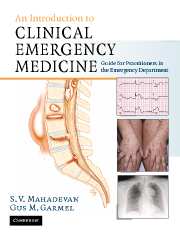Book contents
- Frontmatter
- Contents
- List of contributors
- Foreword
- Acknowledgments
- Dedication
- Section 1 Principles of Emergency Medicine
- Section 2 Primary Complaints
- 9 Abdominal pain
- 10 Abnormal behavior
- 11 Allergic reactions and anaphylactic syndromes
- 12 Altered mental status
- 13 Chest pain
- 14 Constipation
- 15 Crying and irritability
- 16 Diabetes-related emergencies
- 17 Diarrhea
- 18 Dizziness and vertigo
- 19 Ear pain, nosebleed and throat pain (ENT)
- 20 Extremity trauma
- 21 Eye pain, redness and visual loss
- 22 Fever in adults
- 23 Fever in children
- 24 Gastrointestinal bleeding
- 25 Headache
- 26 Hypertensive urgencies and emergencies
- 27 Joint pain
- 28 Low back pain
- 29 Pelvic pain
- 30 Rash
- 31 Scrotal pain
- 32 Seizures
- 33 Shortness of breath in adults
- 34 Shortness of breath in children
- 35 Syncope
- 36 Toxicologic emergencies
- 37 Urinary-related complaints
- 38 Vaginal bleeding
- 39 Vomiting
- 40 Weakness
- Section 3 Unique Issues in Emergency Medicine
- Section 4 Appendices
- Index
23 - Fever in children
Published online by Cambridge University Press: 27 October 2009
- Frontmatter
- Contents
- List of contributors
- Foreword
- Acknowledgments
- Dedication
- Section 1 Principles of Emergency Medicine
- Section 2 Primary Complaints
- 9 Abdominal pain
- 10 Abnormal behavior
- 11 Allergic reactions and anaphylactic syndromes
- 12 Altered mental status
- 13 Chest pain
- 14 Constipation
- 15 Crying and irritability
- 16 Diabetes-related emergencies
- 17 Diarrhea
- 18 Dizziness and vertigo
- 19 Ear pain, nosebleed and throat pain (ENT)
- 20 Extremity trauma
- 21 Eye pain, redness and visual loss
- 22 Fever in adults
- 23 Fever in children
- 24 Gastrointestinal bleeding
- 25 Headache
- 26 Hypertensive urgencies and emergencies
- 27 Joint pain
- 28 Low back pain
- 29 Pelvic pain
- 30 Rash
- 31 Scrotal pain
- 32 Seizures
- 33 Shortness of breath in adults
- 34 Shortness of breath in children
- 35 Syncope
- 36 Toxicologic emergencies
- 37 Urinary-related complaints
- 38 Vaginal bleeding
- 39 Vomiting
- 40 Weakness
- Section 3 Unique Issues in Emergency Medicine
- Section 4 Appendices
- Index
Summary
Scope of the problem
Pediatric fever is one of the more common presenting complaints to the emergency department (ED). The objective of ED evaluation of febrile children is to identify and treat the small subset of children who harbor life-threatening bacterial infections. A febrile infant is at risk for a variety of serious bacterial infections (SBIs), including bacteremia, meningitis, osteomyelitis, suppurative arthritis, skin and soft tissue infection, urinary tract infection, gastroenteritis, and pneumonia. Concurrently, an attempt is made to avoid the indiscriminate use of antibiotics in febrile children. The etiology of a child's fever in the majority of cases is an acute viral infection. Unfortunately, considerable overlap exists in the clinical appearance of a child with occult bacteremia (presence of pathogenic bacteria in the blood of a well-appearing febrile child without an identifiable focus of infection) and a child with fever due to a viral illness. As a result, the broad spectrum of advocated management practices for febrile children continues to be the subject of much research and controversy.
Pathophysiology
Fever results from body temperature elevation above normal circadian variation due to an increase in the hypothalamic thermoregulatory set point. A febrile response is thought to result from enhanced metabolic activity and is mediated by the release of pyrogens. These pyrogens (e.g., tumor necrosis factor, interleukin-1, and interferon) are released from host leukocytes, which in turn reset the temperature regulatory center in the hypothalamus.
- Type
- Chapter
- Information
- An Introduction to Clinical Emergency MedicineGuide for Practitioners in the Emergency Department, pp. 353 - 364Publisher: Cambridge University PressPrint publication year: 2005

